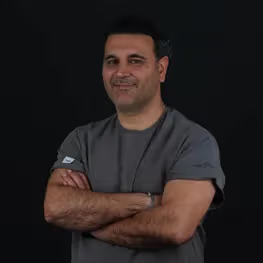Hyperdontia (extra teeth) is a dental condition characterised by extra teeth beyond normal. The extra teeth, called supernumerary teeth, appear anywhere in the dental arch and cause complications depending on their location and alignment. Hyperdontia is detected during routine dental exams or through X-rays, and while some cases are asymptomatic, others lead to significant dental issues requiring professional intervention.
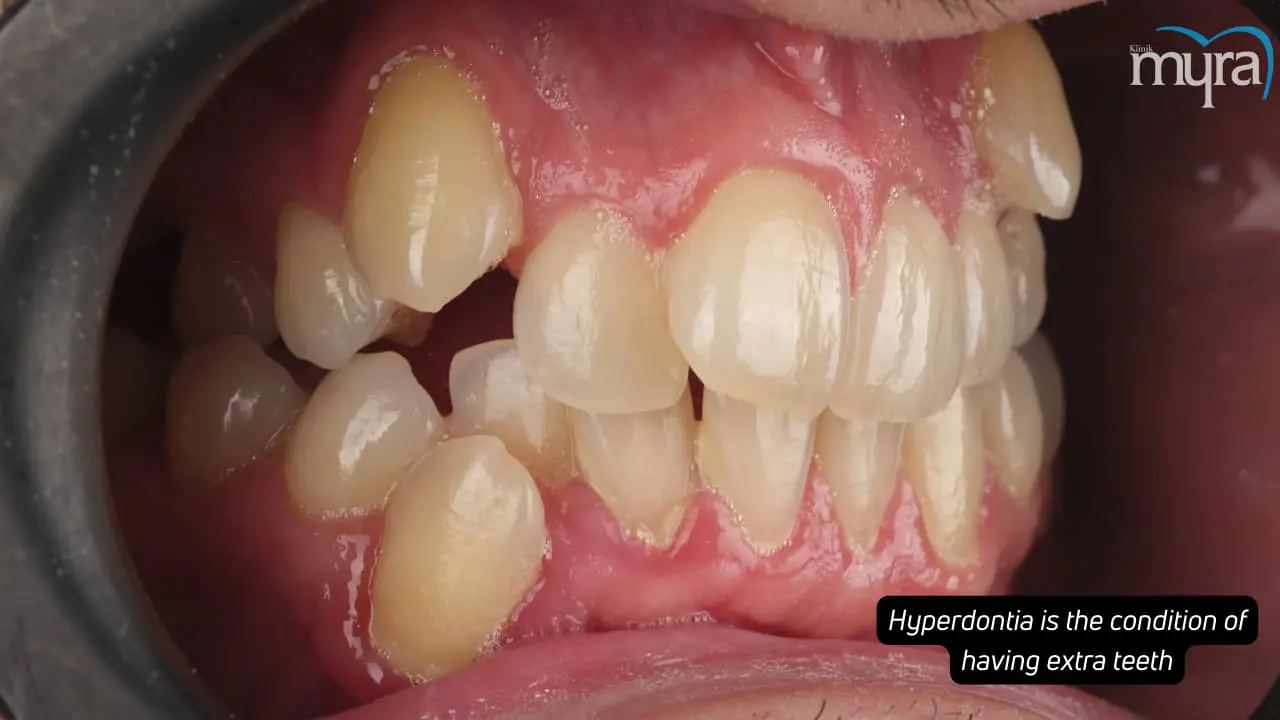
The symptoms of hyperdontia vary widely depending on the number and position of the extra teeth. Common symptoms include pain or tenderness in the gums or jaw bone, swelling around the affected area, and tenderness during the eruption of the extra teeth. Overcrowding is another significant symptom, where the extra teeth cause misalignment and push other teeth out of their normal positions. Overcrowding makes tooth cleaning difficult, increasing the risk of infection and gum disease. Patients experience bad breath and difficulty chewing or eating due to the abnormal positioning of the teeth.
Treating hyperdontia requires professional dental intervention. The treatment is the surgical removal of the extra teeth if they are causing complications such as overcrowding, difficulty maintaining oral hygiene or delaying the eruption of permanent teeth. A surgical extraction is performed under local or general anaesthesia to ensure patient comfort. Orthodontic treatment is necessary to correct the misalignment caused by the extra teeth. Braces or other orthodontic appliances help realign the teeth and jaws properly. Regular monitoring and follow-up care are essential to maintaining dental health after treatment, and maintaining good oral hygiene practices is crucial to preventing further complications.
The causes of hyperdontia are not entirely understood, but several factors are believed to contribute to the condition. Genetics plays a significant role, with hyperdontia running in families. Extra teeth form if the dental lamina (the tissue that makes teeth) is overactive. Atavism, the reappearance of ancestral traits, is another cause, suggesting that ancestors needed extra teeth for their diet. Certain health conditions and syndromes, such as cleidocranial dysplasia and Gardner's syndrome, are associated with an increased likelihood of developing supernumerary teeth.
Other hair conditions cause problems similar to how the hair grows. Hypertrichosis, or excessive hair growth, and hirsutism, excessive hair growth in women in a male-like pattern, are conditions that, like hyperdontia, involve abnormal growth patterns. Alopecia areata, which causes hair loss in small patches, is an opposite condition involving a lack of a physical feature akin to hypodontia (missing teeth). Trichotillomania, a compulsive urge to pull out hair, involves behavioural factors leading to hair loss, paralleling the distress and management that need to be seen in hyperdontia. Congenital hypertrichosis lanuginosa, a rare genetic condition causing excessive fine hair growth, is comparable to congenital hyperdontia cases involving genetic factors that lead to abnormal growth.
The study titled "A Comprehensive Review of the Literature and Data Analysis on Hypo-Hyperdontia" by Anthonappa and colleagues categorised reported cases and found that hypo-hyperdontia occurs most commonly in males, with the bimaxillary type being the most frequent. Another study, "Prevalence of Hyperdontia, Hypodontia, and Concomitant Hypo-Hyperdontia", aimed to determine the prevalence of these conditions among patients and found hyperdontia to be the most prevalent dental anomaly. The study "Non-Syndromic Concomitant Hypo-Hyperdontia in the Anterior Region of Mandible" analysed data from 19 published studies detailing 24 patients affected by the specific dental anomaly. "Hypo-Hyperdontia: A Case Report - SciELO" describes a patient's diagnostic and therapeutic management with hypo-hyperdontia, providing practical insights into the condition's clinical management. The studies collectively enhance the understanding and management of hyperdontia, informing clinical practices and patient care.
What are the Types of Hyperdontia?
The types of Hyperdontia are listed below.
- Paramolar: Paramolars are extra teeth that form next to or adjacent to the uppermost teeth. They are small and conical in shape. They are found near the molar teeth and disrupt normal occlusion, leading to dental crowding and potential alignment issues.
- Distomolar: Distomolars, or fourth molars, are extra teeth that develop behind the third molars (wisdom teeth). The additional molars are rare and appear in the upper and lower jaws. They cause discomfort and complications similar to problems linked with impacted wisdom teeth, such as pain and difficulty in eruption.
- Mesiodens: Mesiodens are extra teeth that develop between the two upper front teeth (incisors). They are the usual type of supernumerary teeth and appear small and peg-shaped. They are found in the midline of the maxilla and are single or multiple. Mesiodens cause crowding and misalignment of the adjacent teeth and sometimes interfere with the development of permanent teeth.
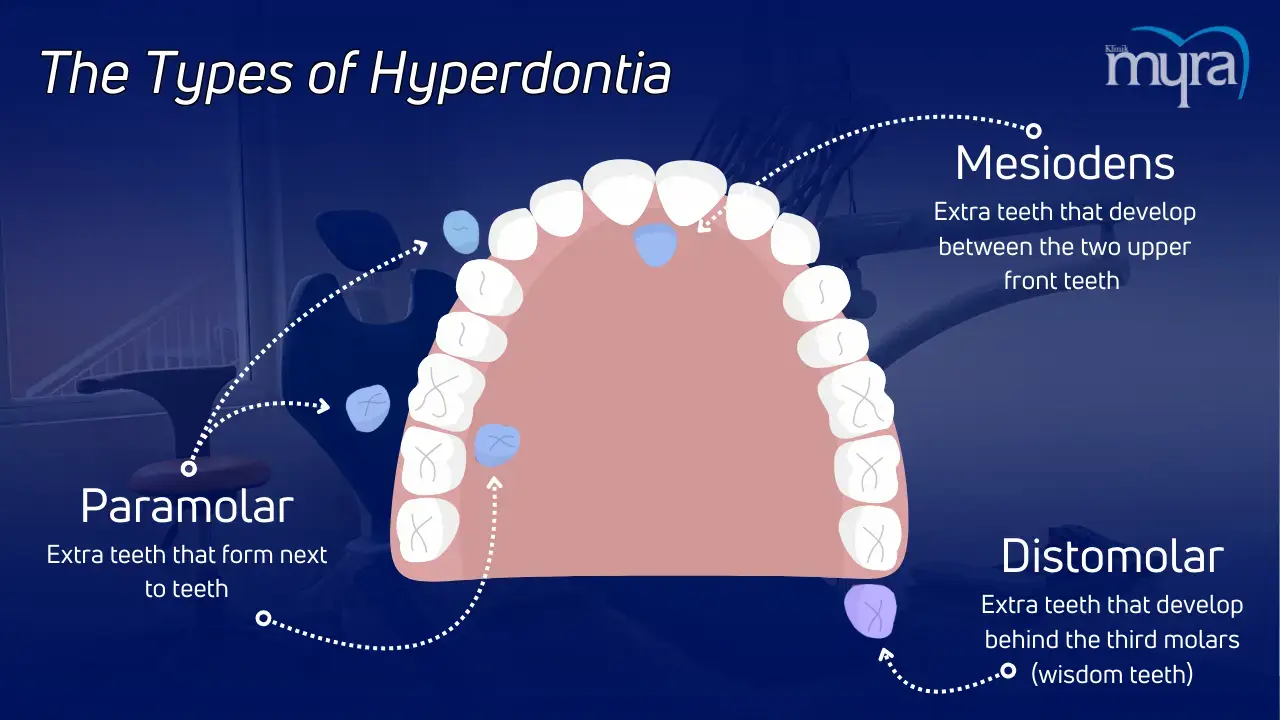
What are the Symptoms of Hyperdontia?
The symptoms of Hyperdontia are listed below.
- Swelling: An abnormal enlargement of the gums or other areas in the mouth. Hyperdontia leads to localised swelling as the extra teeth push against other structures, causing inflammation and puffiness.
- Pain: A discomfort or aching sensation in the mouth or jaw area. Extra teeth cause an ache due to pressure on surrounding teeth and tissues during eruption.
- Tenderness: Sensitivity or soreness in the gums or teeth. The gums around the extra teeth become tender to the touch, making eating and brushing uncomfortable.
- Overcrowding: Overcrowding is the lack of space in the mouth for all the teeth to fit normally. Extra teeth cause overcrowding, leading to misalignment, overlapping teeth, and difficulty maintaining oral hygiene.
- Infection: Infection is the invasion and multiplication of harmful bacteria in the gums or other oral tissues. Hyperdontia increases the risk of infections, such as pericoronitis, due to difficulty cleaning crowded areas, leading to plaque and bacteria buildup.

What are the Causes of Hyperdontia?
The causes of Hyperdontia are listed below.
- Genetics: Inherited traits passed down from parents to offspring. Hyperdontia is a hereditary condition, meaning that if one or both parents have extra teeth, there is a higher likelihood that their kids have the condition.
- Overactive Dental Lamina: Excessive activity of the cells responsible for tooth development. The dental lamina are tissues that form the basis for tooth development. Overactivity in these cells leads to the formation of extra teeth.
- Certain Health Conditions: Medical conditions and syndromes that influence the development of extra teeth. Conditions such as cleidocranial dysplasia, Gardner's syndrome, and other genetic disorders increase the likelihood of developing supernumerary teeth. The conditions disrupt normal dental development and lead to hyperdontia.
- Atavism: Atavism is the reappearance of ancestral genetic traits that have disappeared for generations. It suggests that the genetic trait for extra teeth reappears because distant human ancestors had more teeth to help grind tough, raw foods. The evolutionary throwback manifests as hypodontia.
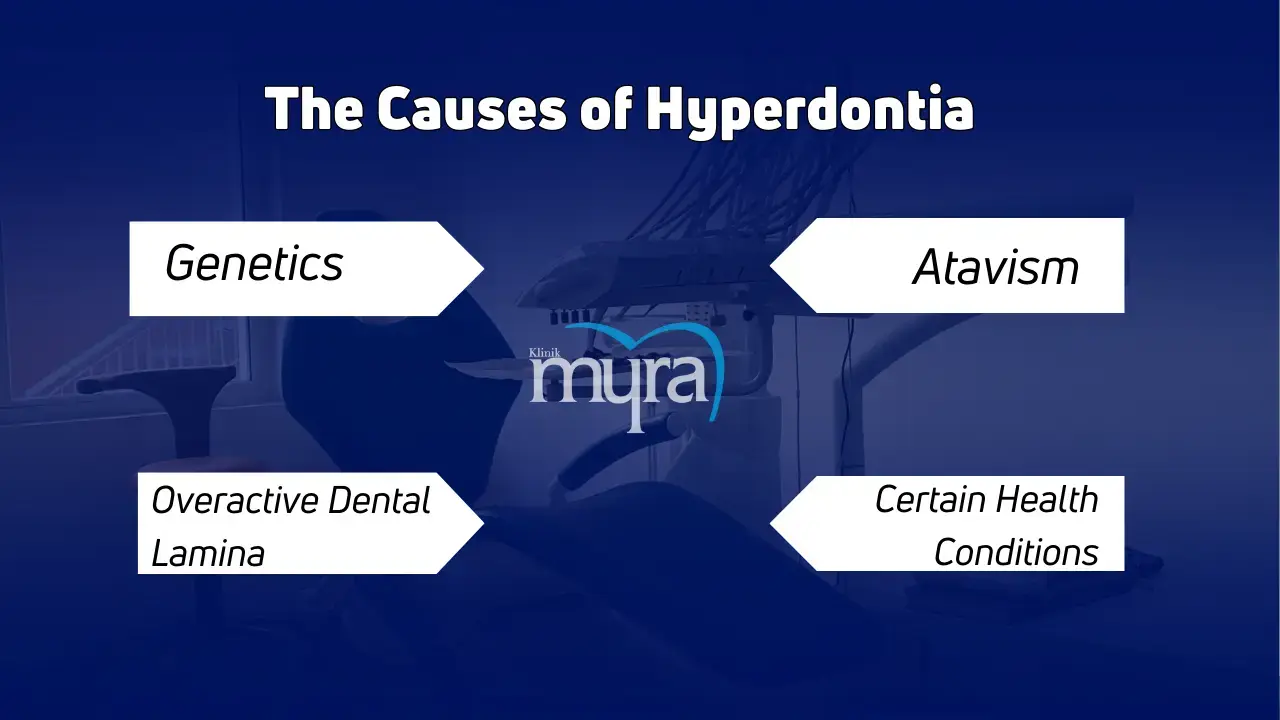
What are the Treatments of Hyperdontia?
The treatments of Hypoerdontia are listed below.
- Observation: Monitoring the extra teeth without immediate intervention. A dentist chooses to observe them over time if the supernumerary teeth are not causing any symptoms or complications. Regular check-ups and X-rays help ensure that they do not begin to cause issues later on.
- Orthodontic Treatment: Procedures to correct misalignment of teeth caused by extra teeth. Orthodontic treatments, like braces, are required to realign the remaining teeth after extracting extra teeth. They help prevent overcrowding and ensure proper dental function.
- Addressing Genetic Disorders: Managing hyperdontia associated with genetic disorders. Removing them as part of a broader treatment plan is beneficial if additional teeth develop due to a genetic disorder. It involves coordinated care with specialists to address the underlying condition and its dental manifestations.
- Preventive Care: Measures to maintain oral health and prevent complications. Proper oral hygiene is crucial if extra teeth complicate cleaning efforts. Dentists recommend specific brushing and flossing techniques or tools to help maintain dental health and prevent gum disease.
- Regular Dental Check-Ups: Frequent dental visits for monitoring and maintenance. Regular check-ups allow the dentist to monitor the condition of the extra teeth and surrounding structures. Early detection of potential problems leads to timely interventions, minimising the risk of complications.
- Extraction: Surgical removal of the extra teeth. Most cases of hyperdontia require the removal of extra teeth if they are causing problems. Tooth extraction is recommended if the extra teeth lead to difficulties chewing or eating, problems cleaning the teeth, overcrowding, or delayed eruption of permanent teeth.
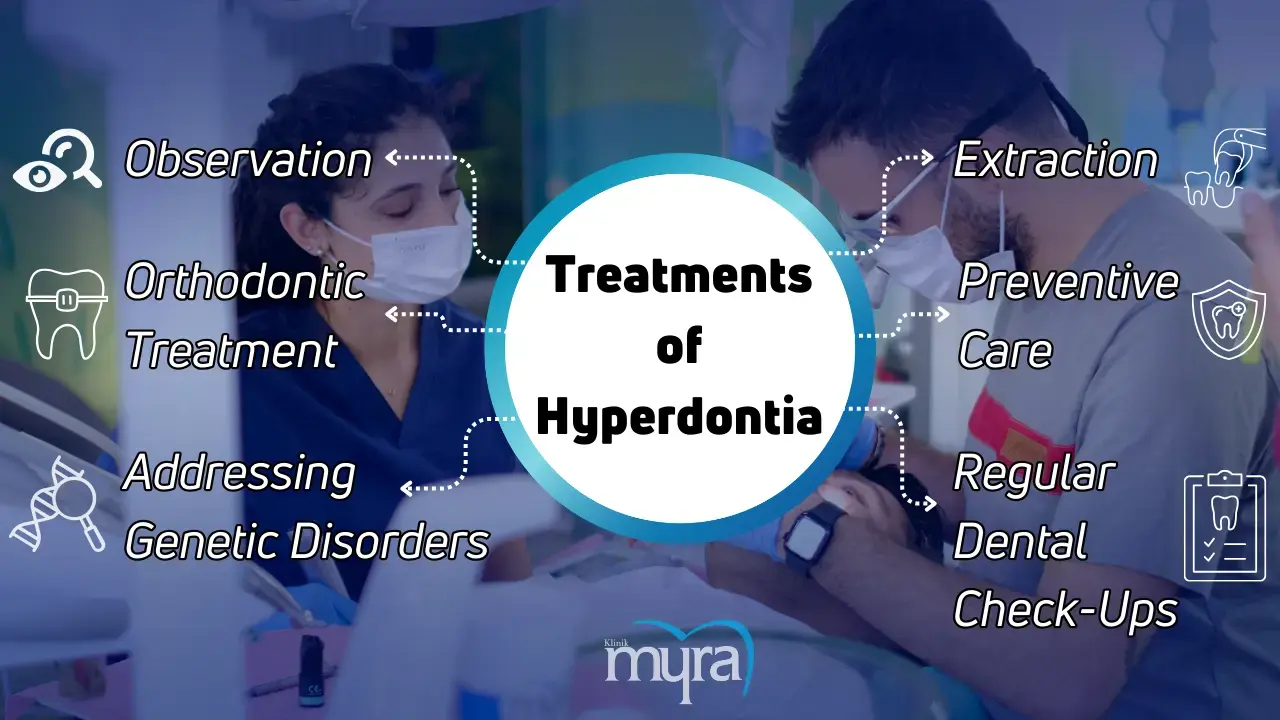
Can Hyperdontia Be Treated At Home?
No, hyperdontia cannot be treated at home. Hyperdontia is characterised by extra teeth, and professional dental intervention is required to manage it effectively. The treatment for hyperdontia involves the surgical removal of the additional teeth. The procedure is necessary to prevent complications such as crowding, misalignment, and difficulties with oral hygiene, leading to further dental issues like gum disease and tooth decay. Surgical extraction is performed by a dentist or oral surgeon under local or general anaesthesia to ensure the patient's comfort and safety. Home remedies or treatments have no match for the precision and effectiveness of these professional procedures.
Orthodontic treatment is needed following the extraction to correct any misalignment caused by the extra teeth. Braces or other orthodontic appliances help correctly align the teeth and jaws, which home care is impossible to manage. The step ensures the remaining teeth are positioned correctly for functional and aesthetic reasons.
Regular monitoring and follow-up care by a dental professional are essential to the treatment plan for hyperdontia. Dentists and orthodontists provide the necessary care and adjustments to maintain oral health and prevent future problems. They prescribe antibiotics and antiseptic rinses to prevent infection post-surgery, another aspect that isn't well handled at home.
What are the research studies about Hyperdontia?
The research about hyperdontia contributes to a deeper understanding of its prevalence, characteristics, and management. The research helps dentists diagnose and treat hyperdontia better by providing detailed evidence and case studies.
Anthonappa and colleagues conducted an extensive review titled "A Comprehensive Review of the Literature and Data Analysis on Hypo-Hyperdontia," categorising reported cases of hypo-hyperdontia, including missing and extra teeth. The study found that hypo-hyperdontia occurs most commonly in males, with the bimaxillary type being the most frequent. The research documented twenty syndromic cases and two familial case studies, highlighting the genetic and clinical aspects of hypo-hyperdontia. The comprehensive review provides valuable insights into the prevalence and characteristics of the condition, making it a significant resource for understanding hypo-hyperdontia.
"Prevalence of Hyperdontia, Hypodontia, and Concomitant Hypo-Hyperdontia" was a study that looked at how common it is for patients to have hypodontia (missing teeth), hyperdontia (extra teeth), and concomitant hypo-hyperdontia. The findings indicated hyperdontia was the most prevalent dental anomaly in the patient population. The research underscores the importance of identifying and managing hyperdontia due to its high prevalence and potential impact on oral health, emphasising the need for regular dental check-ups and appropriate interventions.
The "Non-Syndromic Concomitant Hypo-Hyperdontia in the Anterior Region of Mandible" study focused on non-syndromic cases of hypo-hyperdontia in the anterior mandible region. The review analysed data from 19 published studies detailing 24 patients affected by the specific dental anomaly. Studying cases without related syndromes gives dentists better ideas on how to treat and manage non-syndromic concomitant hypo-hyperdontia.
A case report called "Hypo-Hyperdontia: A Case Report—SciELO" describes how a patient with hypodontia was diagnosed and treated. The detailed case study offers a practical example of how hypo-hyperdontia is identified and treated. It is a valuable reference for dental practitioners, highlighting the importance of thorough diagnostic processes and tailored treatment plans.
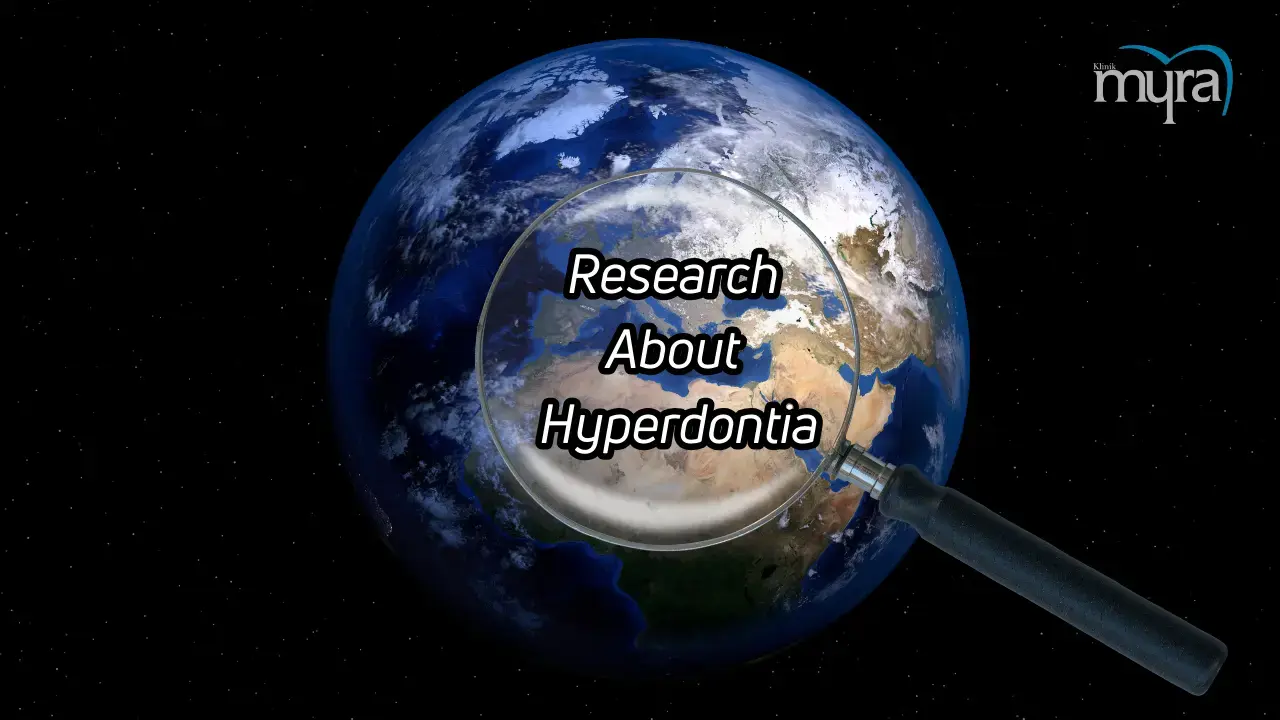
What are the Differences between Hyperdontia and Gap Between Teeth?
The difference between hyperdontia and gaps between teeth lies in their nature and manifestation. Hyperdontia is characterised by having excess teeth (supernumerary teeth). Extra teeth appear anywhere in the dental arch, making it hard for regular teeth to move, bite down, or fit together correctly. Gaps between teeth, or diastema, are the spaces or gaps between two or more teeth seen between the two front teeth. Diastema is a cosmetic concern but sometimes indicates underlying issues like gum disease.
The causes and treatments for hyperdontia and diastema are distinct. Hyperdontia is caused by genetic factors or conditions such as Gardner’s syndrome or cleidocranial dysostosis. Treatment involves extracting supernumerary teeth to prevent crowding and misalignment, followed by orthodontic treatments to align the remaining teeth properly. Diastema results from genetic factors, a mismatch between tooth and jaw size, missing teeth, or habits like thumb sucking. Treatments for diastema include cosmetic procedures such as dental bonding, porcelain veneers, braces, and sometimes dental implants if gaps are due to missing teeth. Gum disease-related diastema requires periodontal treatment before any cosmetic procedure.

Hyperdontia and diastema share similarities regarding their impact on dental health and aesthetics. Hyperdontia and diastema affect the alignment of teeth and the smile's appearance. They are managed and treated with orthodontic procedures to achieve a more functional and aesthetically pleasing dental arrangement. Regular dental check-ups are essential for identifying and managing these conditions early, ensuring proper dental health and alignment. Seeking professional dental care is necessary for good oral health, whether they have extra teeth or a gap between teeth.

